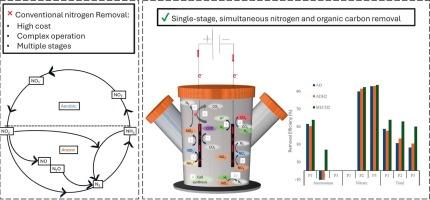Bio-electrochemical nitrogen removal in wastewater: Coupling anodic ammonium oxidation with hydrogenotrophic denitrification in a microbial electrolysis cell
IF 4.5
2区 化学
Q1 BIOCHEMISTRY & MOLECULAR BIOLOGY
引用次数: 0
Abstract
The increasing need for efficient nitrogen removal in wastewater treatment has driven interest in innovative biological and electrochemical approaches that can simultaneously address ammonium and nitrate contamination. This study explored the performance of simultaneous anodic ammonium oxidation and hydrogenotrophic denitrification in a single-chamber microbial electrolysis cell (MEC). Different operational conditions, including varying ammonia‑nitrogen/nitrate‑nitrogen ratios, were selected to evaluate the MEC's ability to promote anaerobic ammonium oxidation along with organic matter removal. The results demonstrated that the single-stage MEC achieved 57.8 % total nitrogen removal efficiency under an optimal condition where the influent contained only ammonium nitrogen at 200 mg/L with no added nitrate. Adding nitrate in the influent of the microbial electrolysis system decreased ammonium removal in all the operational conditions. Additionally, chemical oxygen demand (COD) destruction and methane production occurred uninterrupted throughout all experimental stages. Therefore, simultaneous methane production and nitrogen removal was realized in this study. The microbial electrolysis system achieved 97.3 ± 0.5 % nitrate removal, outperforming the hydrogenotrophic anaerobic digestion system. While no nitrite accumulation was observed in the systems, nitrous oxide emission occurred in all the operational conditions. A microbial community analysis showed that the anode of the MEC reactor was dominated by Pseudothauera and clostridium, which explained the denitrification performance by the MEC. This highlights the potential of bioelectrochemical systems for simultaneous ammonium and nitrate removal in a single-stage wastewater treatment process.

废水的生物电化学脱氮:在微生物电解池中耦合阳极铵氧化与氢营养化反硝化
废水处理中对高效脱氮的需求日益增加,这促使人们对创新的生物和电化学方法产生了兴趣,这些方法可以同时处理铵和硝酸盐污染。研究了在单室微生物电解池(MEC)中同时进行阳极铵氧化和加氢营养化反硝化的性能。选择不同的操作条件,包括不同的氨氮/硝态氮比例,来评估MEC促进厌氧氨氧化和有机物去除的能力。结果表明,单级MEC在只投入200 mg/L铵态氮且不添加硝酸盐的条件下,总氮去除率达到57.8%。在微生物电解系统进水中添加硝酸盐降低了所有操作条件下的铵去除率。此外,在整个实验阶段,化学需氧量(COD)的破坏和甲烷的产生都是不间断的。因此,本研究实现了同时产甲烷和脱氮。微生物电解系统的硝酸盐去除率为97.3±0.5%,优于氢营养厌氧消化系统。虽然在系统中没有观察到亚硝酸盐积累,但在所有操作条件下都发生了氧化亚氮排放。微生物群落分析表明,MEC反应器的阳极以伪氏菌和梭菌为主,这解释了MEC的脱氮性能。这突出了生物电化学系统在单级废水处理过程中同时去除铵和硝酸盐的潜力。
本文章由计算机程序翻译,如有差异,请以英文原文为准。
求助全文
约1分钟内获得全文
求助全文
来源期刊

Bioelectrochemistry
生物-电化学
CiteScore
9.10
自引率
6.00%
发文量
238
审稿时长
38 days
期刊介绍:
An International Journal Devoted to Electrochemical Aspects of Biology and Biological Aspects of Electrochemistry
Bioelectrochemistry is an international journal devoted to electrochemical principles in biology and biological aspects of electrochemistry. It publishes experimental and theoretical papers dealing with the electrochemical aspects of:
• Electrified interfaces (electric double layers, adsorption, electron transfer, protein electrochemistry, basic principles of biosensors, biosensor interfaces and bio-nanosensor design and construction.
• Electric and magnetic field effects (field-dependent processes, field interactions with molecules, intramolecular field effects, sensory systems for electric and magnetic fields, molecular and cellular mechanisms)
• Bioenergetics and signal transduction (energy conversion, photosynthetic and visual membranes)
• Biomembranes and model membranes (thermodynamics and mechanics, membrane transport, electroporation, fusion and insertion)
• Electrochemical applications in medicine and biotechnology (drug delivery and gene transfer to cells and tissues, iontophoresis, skin electroporation, injury and repair).
• Organization and use of arrays in-vitro and in-vivo, including as part of feedback control.
• Electrochemical interrogation of biofilms as generated by microorganisms and tissue reaction associated with medical implants.
 求助内容:
求助内容: 应助结果提醒方式:
应助结果提醒方式:


